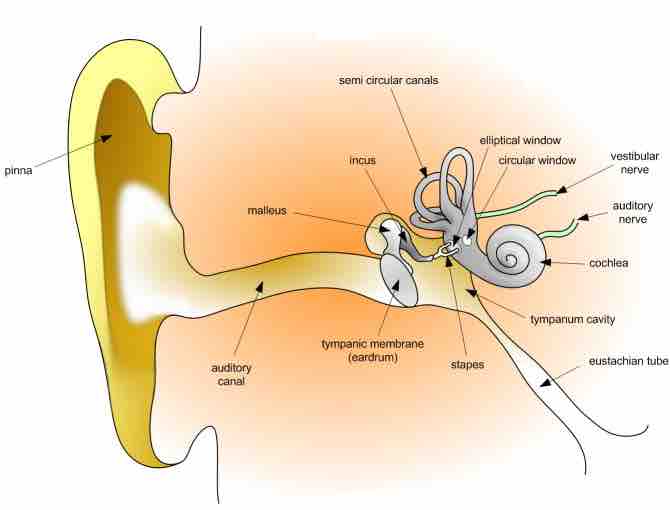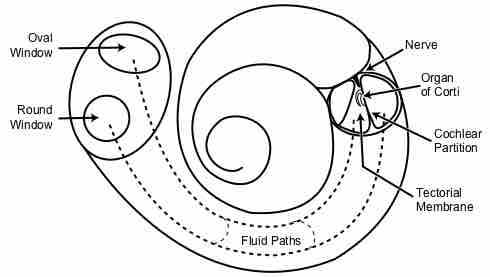The human auditory system allows the body to collect and interpret sound waves into meaningful messages. The main sensory organ responsible for the ability to hear is the ear, which can be broken down into the outer ear, middle ear, and inner ear. The inner ear contains the receptor cells necessary for both hearing and equilibrium maintenance. Human beings also have the special ability of being able to estimate where sounds originate from, commonly called sound localization.
The Ear
The ear is the main sensory organ of the auditory system. It performs the first processing of sound and houses all of the sensory receptors required for hearing. The ear's three divisions (outer, middle, and inner) have specialized functions that combine to allow us to hear.

Anatomy of the human ear
The outer ear, middle ear, and inner ear.
The outer ear is the external portion of the ear, much of which can be seen on the outside of the human head. It includes the pinna, the ear canal, and the most superficial layer of the ear drum, the tympanic membrane. The outer ear's main task is to gather sound energy and amplify sound pressure. The pinna, the fold of cartilage that surrounds the ear canal, reflects and attenuates sound waves, which helps the brain determine the location of the sound. The sound waves enter the ear canal, which amplifies the sound into the ear drum. Once the wave has vibrated the tympanic membrane, sound enters the middle ear.
The middle ear is an air-filled tympanic (drum-like) cavity that transmits acoustic energy from the ear canal to the cochlea in the inner ear. This is accomplished by a series of three bones in the middle ear: the malleus, the incus, and the stapes. The malleus (Latin for "hammer") is connected to the mobile portion of the ear drum. It senses sound vibrations and transfers them onto the incus. The incus (Latin for "anvil") is the bridge between the malleus and the stapes. The stapes (Latin for "stirrup") transfers the vibrations from the incus to the oval window, the portion of the inner ear to which it is connected. Through these steps, the middle ear acts as a gatekeeper to the inner ear, protecting it from damage by loud sounds.
Unlike the middle ear, the inner ear is filled with fluid. When the stapes footplate pushes down on the oval window in the inner ear, it causes movement in the fluid within the cochlea. The function of the cochlea is to transform mechanical sound waves into electrical or neural signals for use in the brain. Within the cochlea there are three fluid-filled spaces: the tympanic canal, the vestibular canal, and the middle canal. Fluid movement within these canals stimulates hair cells of the organ of Corti, a ribbon of sensory cells along the cochlea. These hair cells transform the fluid waves into electrical impulses using cilia, a specialized type of mechanosensor.

The cochlea
A cross-section of the cochlea, the main sensory organ of hearing, located in the inner ear.
The Process of Hearing
Hearing begins with pressure waves hitting the auditory canal and ends when the brain perceives sounds. Sound reception occurs at the ears, where the pinna collects, reflects, attenuates, or amplifies sound waves. These waves travel along the auditory canal until they reach the ear drum, which vibrates in response to the change in pressure caused by the waves. The vibrations of the ear drum cause oscillations in the three bones in the middle ear, the last of which sets the fluid in the cochlea in motion. The cochlea separates sounds according to their place on the frequency spectrum. Hair cells in the cochlea perform the transduction of these sound waves into afferent electrical impulses. Auditory nerve fibers connected to the hair cells form the spiral ganglion, which transmits the electrical signals along the auditory nerve and eventually on to the brain stem. The brain responds to these separate frequencies and composes a complete sound from them.

Structural diagram of the cochlea
The cochlea is the snail-shaped portion of the inner ear responsible for sound wave transduction.
Sound Localization
Humans are able to hear a wide variety of sound frequencies, from approximately 20 to 20,000 Hz. Our ability to judge or estimate where a sound originates, called sound localization, is dependent on the hearing ability of each ear and the exact quality of the sound. Since each ear lies on an opposite side of the head, a sound reaches the closest ear first, and the sound's amplitude will be larger (and therefore louder) in that ear. Much of the brain's ability to localize sound depends on these interaural (between-the-ears) differences in sound intensity and timing. Bushy neurons can resolve time differences as small as ten milliseconds, or approximately the time it takes for sound to pass one ear and reach the other.